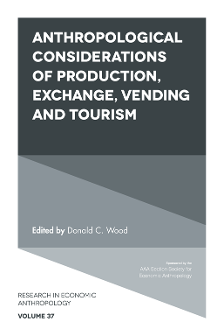
Index
Anthropological Considerations of Production, Exchange, Vending and Tourism
ISBN: 978-1-78743-195-9, eISBN: 978-1-78743-194-2
ISSN: 0190-1281
Publication date: 10 August 2017
Citation
(2017), "Index", Anthropological Considerations of Production, Exchange, Vending and Tourism (Research in Economic Anthropology, Vol. 37), Emerald Publishing Limited, Leeds, pp. 281-288. https://doi.org/10.1108/S0190-128120170000037026
Publisher
:Emerald Publishing Limited
Copyright © 2017 Emerald Publishing Limited
INDEX
- Prelims
- Part I Production
- Cultural Economics and Ramifications of Home-Brewing, Selling and Consumption of Alcohol among the Maragoli of Western Kenya
- Synergistic Change and Smallholder Agriculture in Pérez Zeledón, Costa Rica
- Transition to Farming More Likely in a Land of Plenty
- Part II Exchange
- Long-Distance Exchange and Centralized Political Power in Precolumbian America
- Markets of the Heart: Weighing Economic and Ethical Values at Ten Thousand Villages
- Provisioning, Shopping and Productive Leisure at North Market, Columbus, Ohio
- Relative Customers: Demand-Sharing, Kinship and Selling in Solomon Islands
- Part III Vending
- Struggles with Changing Politics: Street Vendor Livelihoods in Contemporary China
- Sons of Peasants on the Beach: Vendors in Cabo San Lucas, Mexico
- Part IV Tourism
- Debts and Uncertainty: Circulation of Advance Money among Tourism Entrepreneurs in Agra, India
- Making “Easy” Money: Resilience and Risk in Jamaica
- About the Authors
- Index